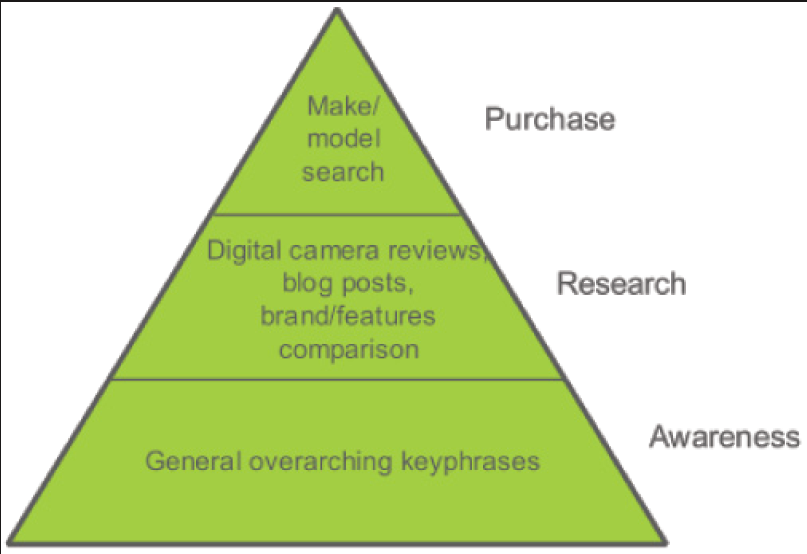Capturing Clicks With Powerful Keyphrases: Targeting the Buying Cycle
 Today, we’re setting aside market research and turning our attention towards discovering powerful keyphrases to capture our prospects’ “clicks.” As you well know, simply building the site does not mean that they will come, anymore than hanging an “open”sign in your storefront window will generate business!
Today, we’re setting aside market research and turning our attention towards discovering powerful keyphrases to capture our prospects’ “clicks.” As you well know, simply building the site does not mean that they will come, anymore than hanging an “open”sign in your storefront window will generate business!
As with an actual store, you need to consider your: competition, strategic position (strengths, weaknesses, opportunities, and threats), perfect customer profile, and finally, your U.S.P. (unique selling proposition).
And, as with actual stores, you also need to strive for: Location, location, location! By location, I’m referring not only to your search engine results page (SERP) ranking, but where on your website you place your critical keyphrases. How do you beat out the competition with a superior keyphrase strategy?
Keyphrase research and strategy are, well, key to your success in SEO copywriting and content marketing, period. To neglect this step is risky at best. More likely, it will kill the best of your copywriting and marketing efforts. So read on, and see how to target your prospects’ buying cycle to develop a successful, conversions-driving keyphrase strategy!
A solid first step is to develop a keyphrase list that addresses your prospect wherever they’re at in the buying cycle: are they merely browsing? Are they actively researching? Are they ready to purchase? Then you can optimize your web pages throughout your site accordingly…and you will be rewarded, both by search engines and by conversions!
The Buying Cycle
Let’s start with the assumption that your prospect is merely aware of your product (in this example, digital cameras), and is “browsing”around the web: this can be described as the “awareness” phase of the buying cycle. This is represented by the bottom part of the triangle. The prospect knows they want to buy a digital camera, but s/he doesn’t know what kind of camera, or the desired features.
At this point, the prospect is typing in general search terms (such as “digital camera”) to help spark some ideas. To capture clicks from your prospects in this “window shopping” phase, you will want to use general, overarching keyphrases in your content. The most opportune places? Your home and subcategory pages.
The middle section of the buy cycle represents the “research” phase of the buy cycle. The prospect has done some initial searches which have sparked some choices. Now, s/he’s looking for specific information, reviewing options, and narrowing down the choices. Chances are, s/he’s typing in search phrases like “digital camera reviews,” or “compare digital cameras.”
To hone in on this stage of the buy cycle, you’ll want to have review pages and articles, such as “how to select a digital camera,” and “comparing SLR digital cameras.” Whether you sell products or services, consider writing articles and/or blog posts. Content is a great way to reach your prospects when they’re looking for information, and once they find your site, they can surf around and see what else you have to offer!
Finally, we come to the top part of the triangle, representing the “purchase” phase of the buy cycle. This means your prospect is ready to buy or contact you for more information. Keyphrases reflecting more specific and focused search terms, such as the camera make or model, should be incorporated in your site…and where? Yes, your product pages, where you would optimize for products-related keyphrases (such as “Snaptix 10.1 megapixel zoom prices”).
Ideally, your site should have keyphrases representing the entire buy cycle. To recap, your home and subcategory pages would contain general keyphrases, you’d have review pages and articles to capture folks at the “research” phase, while your products page would expertly focus on keyphrases specific to your products/services.
By developing a site-wide keyphrase strategy, your brand is front and center during all phases of the buy cycle: location, location, location!


“Ideally, your site should have keyphrases representing the entire buy cycle.” Couldn’t agree, very smart. Great post Laura, keyword research and implementation of those keywords can make or break you. Appreciate the info.
You’re most welcome, Domenick! I learned this, and so much more, by taking Heather’s SEO Copywriting Certification Training program. If you haven’t yet, check out the training link on this site :-)